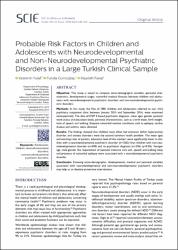Probable Risk Factors in Children and Adolescents with Neurodevelopmental and Non-Neurodevelopmental Psychiatric Disorders in a Large Turkish Clinical Sample
Özet
Objective: This study is aimed to compare socio-demographic variables, perinatal characteristics, developmental stages, comorbid medical illnesses between children and adolescents with neurodevelopmental psychiatric disorders and non-neurodevelopmental psychiatric disorders.
Methods: In this study, the files of 2981 children and adolescents referred to our, child
psychiatry outpatient clinic between January 2015 and September 2016, were examined
retrospectively. The data of DSM 5 based psychiatric diagnosis, mean ages, gender, parental
work status and education levels, perinatal characteristics, such as a birth week, birth weight,
time of speech and walking, frequent comorbid medical conditions such as epilepsy, cardiac
disease and asthma, were obtained.
Results: The findings showed that children most often had attention deficit hyperactivity
disorder, and anxiety disorders were the second common health problem. The mean ages
and working rates of parents, education level of the mothers were significantly lower in children with a neurodevelopmental psychiatric disorder (n=1502) than children with non-neurodevelopmental disorder (n=690) and no psychiatric diagnosis (n=376) (p<0.05). Younger
age, male gender, the requirement of neonatal intensive care unit, speech and walking delay
and presence of comorbid epilepsy were associated with a neurodevelopmental psychiatric
disorder.
Conclusion: Knowing socio-demographic, developmental, medical and perinatal variables
associated with neurodevelopmental and non-neurodevelopmental psychiatric disorders
may help us to develop preventive interventions.
Cilt
30Sayı
4Bağlantı
https://hdl.handle.net/11363/6425Koleksiyonlar
Aşağıdaki lisans dosyası bu öğe ile ilişkilidir:


















